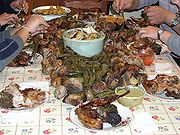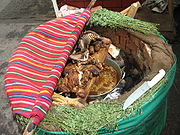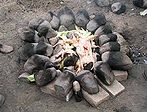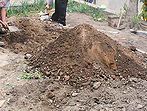
Pachamanca
Encyclopedia


Peru
Peru , officially the Republic of Peru , is a country in western South America. It is bordered on the north by Ecuador and Colombia, on the east by Brazil, on the southeast by Bolivia, on the south by Chile, and on the west by the Pacific Ocean....
vian dish based on the baking
Baking
Baking is the technique of prolonged cooking of food by dry heat acting by convection, and not by radiation, normally in an oven, but also in hot ashes, or on hot stones. It is primarily used for the preparation of bread, cakes, pastries and pies, tarts, quiches, cookies and crackers. Such items...
, with the aid of hot stones (the earthen oven is known as a huatia
Huatia
A huatia is a traditional Peruvian earthen oven which dates back to the days of the Inca Empire. A banquet prepared with this sort of oven is known as a Pachamanca...
), of lamb, mutton, pork
Pork
Pork is the culinary name for meat from the domestic pig , which is eaten in many countries. It is one of the most commonly consumed meats worldwide, with evidence of pig husbandry dating back to 5000 BC....
, chicken
Chicken
The chicken is a domesticated fowl, a subspecies of the Red Junglefowl. As one of the most common and widespread domestic animals, and with a population of more than 24 billion in 2003, there are more chickens in the world than any other species of bird...
or guinea pig
Guinea pig
The guinea pig , also called the cavy, is a species of rodent belonging to the family Caviidae and the genus Cavia. Despite their common name, these animals are not in the pig family, nor are they from Guinea...
, marinated in spice
Spice
A spice is a dried seed, fruit, root, bark, or vegetative substance used in nutritionally insignificant quantities as a food additive for flavor, color, or as a preservative that kills harmful bacteria or prevents their growth. It may be used to flavour a dish or to hide other flavours...
s. Other Andean
Andes
The Andes is the world's longest continental mountain range. It is a continual range of highlands along the western coast of South America. This range is about long, about to wide , and of an average height of about .Along its length, the Andes is split into several ranges, which are separated...
produce, such as potato
Potato
The potato is a starchy, tuberous crop from the perennial Solanum tuberosum of the Solanaceae family . The word potato may refer to the plant itself as well as the edible tuber. In the region of the Andes, there are some other closely related cultivated potato species...
, green lima beans or "habas", sweet potato
Sweet potato
The sweet potato is a dicotyledonous plant that belongs to the family Convolvulaceae. Its large, starchy, sweet-tasting, tuberous roots are an important root vegetable. The young leaves and shoots are sometimes eaten as greens. Of the approximately 50 genera and more than 1,000 species of...
, and occasionally cassava
Cassava
Cassava , also called yuca or manioc, a woody shrub of the Euphorbiaceae native to South America, is extensively cultivated as an annual crop in tropical and subtropical regions for its edible starchy tuberous root, a major source of carbohydrates...
, as well as ears of corn
Maize
Maize known in many English-speaking countries as corn or mielie/mealie, is a grain domesticated by indigenous peoples in Mesoamerica in prehistoric times. The leafy stalk produces ears which contain seeds called kernels. Though technically a grain, maize kernels are used in cooking as a vegetable...
, tamale
Tamale
A tamale — or more correctly tamal — is a traditional Latin American dish made of masa , which is steamed or boiled in a leaf wrapper. The wrapping is discarded before eating...
and chile, is included in the baking.
The dish is essentially made in the central Peruvian Andes in three main regions: 1) the upper Huallaga valley, in Huánuco and Pasco vicinity, where it is made with pork and seasoned with chincho, a local herb; 2) in the Mantaro valley and neighboring area around cities like Huancayo, Tarma and Jauja; they use lamb and a different seasoning; and 3) in several places of Ayacucho department. In the Peruvian Amazonia, the southern and northern Andes, and the mostly desertic coast the dish is uncommon due to the lack of firewood or the type of stones needed without any content of sulphur. Meat is wrapped with banana
Banana
Banana is the common name for herbaceous plants of the genus Musa and for the fruit they produce. Bananas come in a variety of sizes and colors when ripe, including yellow, purple, and red....
leaves before to be put in this kind of earthen stove.
The word is made of two Quechua
Quechua languages
Quechua is a Native South American language family and dialect cluster spoken primarily in the Andes of South America, derived from an original common ancestor language, Proto-Quechua. It is the most widely spoken language family of the indigenous peoples of the Americas, with a total of probably...
roots: "pacha" and "manca", meaning "earthen pot" (cooking vessel).
This important part of Peruvian cuisine
Cuisine
Cuisine is a characteristic style of cooking practices and traditions, often associated with a specific culture. Cuisines are often named after the geographic areas or regions that they originate from...
, which has existed since the time of the Inca Empire
Inca Empire
The Inca Empire, or Inka Empire , was the largest empire in pre-Columbian America. The administrative, political and military center of the empire was located in Cusco in modern-day Peru. The Inca civilization arose from the highlands of Peru sometime in the early 13th century...
, has evolved over time, and its consumption is now widespread throughout modern Peru, where regional variations have appeared in the technical process of production, but not in the ingredients or their baking. It's important to note that the preparation is not only limited to Peru, but also that it exists with minimal variants in other Andean countries, for example Ecuador
Ecuador
Ecuador , officially the Republic of Ecuador is a representative democratic republic in South America, bordered by Colombia on the north, Peru on the east and south, and by the Pacific Ocean to the west. It is one of only two countries in South America, along with Chile, that do not have a border...
.
Preparation
 |
 |
 |
 |
Preparation begins with the heating of stones over a fire
Fire
Fire is the rapid oxidation of a material in the chemical process of combustion, releasing heat, light, and various reaction products. Slower oxidative processes like rusting or digestion are not included by this definition....
, and the meat
Meat
Meat is animal flesh that is used as food. Most often, this means the skeletal muscle and associated fat and other tissues, but it may also describe other edible tissues such as organs and offal...
is then placed on top. The fire is covered with grass
Grass
Grasses, or more technically graminoids, are monocotyledonous, usually herbaceous plants with narrow leaves growing from the base. They include the "true grasses", of the Poaceae family, as well as the sedges and the rushes . The true grasses include cereals, bamboo and the grasses of lawns ...
and earth, and the resulting oven
Oven
An oven is a thermally insulated chamber used for the heating, baking or drying of a substance. It is most commonly used for cooking. Kilns, and furnaces are special-purpose ovens...
is opened up after around an hour and a half. Usually, a large quantity of meat is cooked, perhaps a whole sheep, to serve several people.
External links
See also
- CurantoCurantoCuranto is a traditional food of Chiloé Archipelago that has spread to the southern areas of Chile and recently Argentina. It is traditionally prepared in a hole, about a meter and a half deep, which is dug in the ground...
(Chile) - HangiHangiHāngi is a traditional New Zealand Māori method of cooking food using heated rocks buried in a pit oven still used for special occasions.To "lay a hāngi" or "put down a hāngi" involves digging a pit in the ground, heating stones in the pit with a large fire, placing baskets of food on top of the...
(New Zealand) - KaluaKaluaKālua is a traditional Hawaiian cooking method that utilizes an imu, a type of underground oven. The word kālua, which literally means "to cook in an underground oven", may also be used to describe the food cooked in this manner, such as kālua pig or kālua turkey, which are commonly served at luau...
(Hawaii) - Clam bake (New England)

